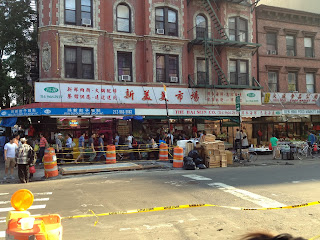Nathalie Martinez
Queens Boulevard
Queens Boulevard had the fame of being the "Boulevard of Death" because of the numerous pedestrian deaths in the past. However, after 2001 new traffic regulations were implemented reducing the number of accidents and deaths. There are signs placed on certain intersections along the boulevard to remind drivers to be cautious on the road.
Queens Boulevard starts from the Ed Koch/Queens Borough Bridge and ends at Jamaica Boulevard. It crosses through various neighborhoods such as:
- Sunnyside
- Woodside
- Elmhurst
- Rego Park
- Forest Hills
- Kew Gardens
- Briarwood
- Jamaica
Queens Boulevard does not have any bicycle lanes. I decided to drive and walk along the boulevard to observe the movement of traffic, any bicyclists that happen to be riding, and potential sites for bike routes to be implemented along the way.
 | ||
Route I took along Queens Boulevard
|
I looked on google maps it recommends 2 alternative routes for bicyclists to take from Jamaica Ave. to Queens Bridge.
 |
| Cycle Route via Main Street, Flushing Meadow Park, 111th Street, 34ave and Skillman Avenue |
 |
| Cycle Route via Kew Garden Road, Austin Street, Wetherole Street and Woodhaven Boulevard |
ROUTE ALONG QUEENS BLVD
I decided to start my route from Jamaica Avenue, noticing that the road had 4 lanes , two in each direction.
 |
| Jamaica Avenue and Queens Boulevard |
 |
| Jamaica Avenue and Queens Boulevard |
As I got to Hillside Avenue, a main intersection the boulevard widened up and now had 6 lanes, 3 in each direction. I decided to focus on a cyclist that was riding from Hillside, along Queens Blvd. He wasn't wearing a helmet, drove pass a red light. Although he waited for the green van to pass, it would've been wise to just wait until light turned green to go.

Queens Blvd is one the busiest areas in this borough, it has a lot of business as well as residential buildings. Since there are a lot of restaurants along this blvd, there are deliveries conducted via bicycle.


Delivery man, wearing helmet and reflective vest, but driving against traffic.
I then headed towards 76th road where the road split into express lanes and service road. There are 6 center lanes (3 going in each direction)and 3 outer lanes in each direction. The service road has three functions: serves as parking along both sides, road for vehicle and a bus route for local buses. The center lanes are used by vehicles and express buses that turn onto boulevard from Union Turnpike (West direction) and turn onto Union Turnpike (east) .
 When I reached Yellowstone Boulevard the lanes expanded to 16 lanes. Now there were 8 in the center (4 in both directions), 3 on the service road (West direction) and 5 on the service road (East direction). This was reduced back to a total of 12 lanes once I reached Harry Van Arsdale Jr Avenue (distance of 1 block).
As I continued along the boulevard I saw a couple of bicyclist with no protective gear and riding in what I considered an unsafe manner. Riding on the right side of a bus, riding against traffic, group riding on same lane as vehicles.
|



This delivery man crossed when the traffic light was not in his favor according to direction he was headed in.

----------------------------------------------------------------------------------------------------------
The more I continued the more I thought about where possible bike lanes or a bike traffic light could be placed. There enough space on the boulevard, specially on the service road.
The more I continued the more I thought about where possible bike lanes or a bike traffic light could be placed. There enough space on the boulevard, specially on the service road.


On my way to Long Island City the road started to change again, there where 5 lanes on each side of the boulevard.
As I reached a very congested intersection, Van Dam street, my idea introducing a bike lane was weakened.
 But very shortly, after crossing an overpass or small bridge that led me to Jackson Avenue, did I come across existing bike lanes.
But very shortly, after crossing an overpass or small bridge that led me to Jackson Avenue, did I come across existing bike lanes. 

These bike lanes continued onto the Ed Koch Bridge, giving commuters another option to get into Manhattan.
My suggestion after making these observations were that Queens Boulevard can potentially have continuous bike lanes. Ideal location of the lanes would be along the service roads in each direction. The only problem it would encounter would be on the existing lanes that are used for street parking. These lanes would have to be shared with the bike lines. Another option would be to remove street parking on the side closest to the side walk (since there are two sides to park in each direction); or converting the median on boulevard into a bike lane all the way from Hillside Avenue to Sunnyside. If this can not take place, then another suggestion would be to place traffic light for bicycles, give them as much time to cross, just like it is given for vehicles to turn left at an intersection.
If lanes are not placed, this will not stop bicyclists from risking themselves to be part of an accident. So why not place something to regulate their riding which will be of beneficial to both the rider and those who drive around them.


































